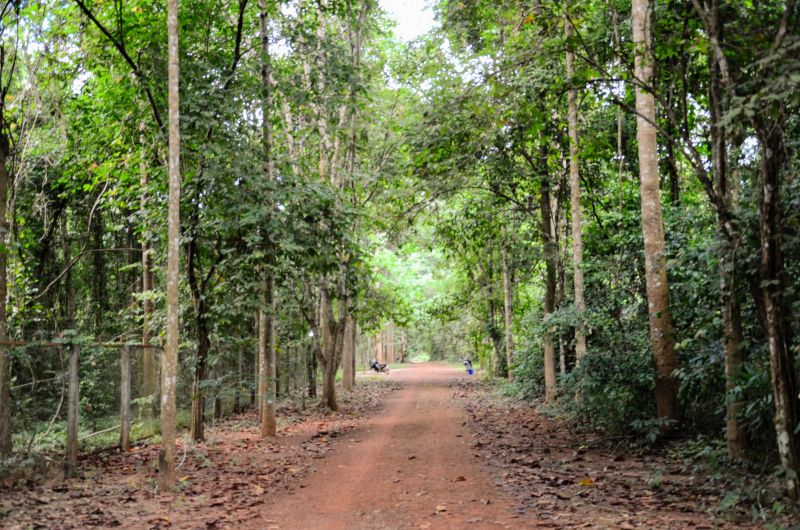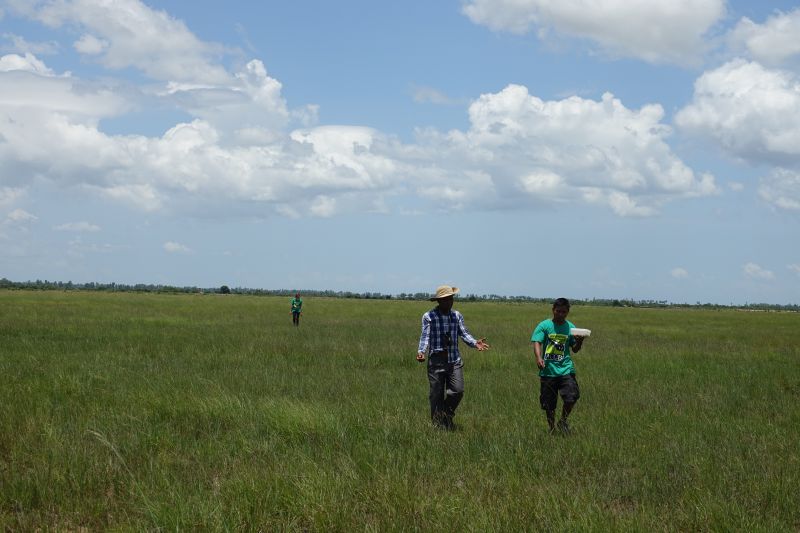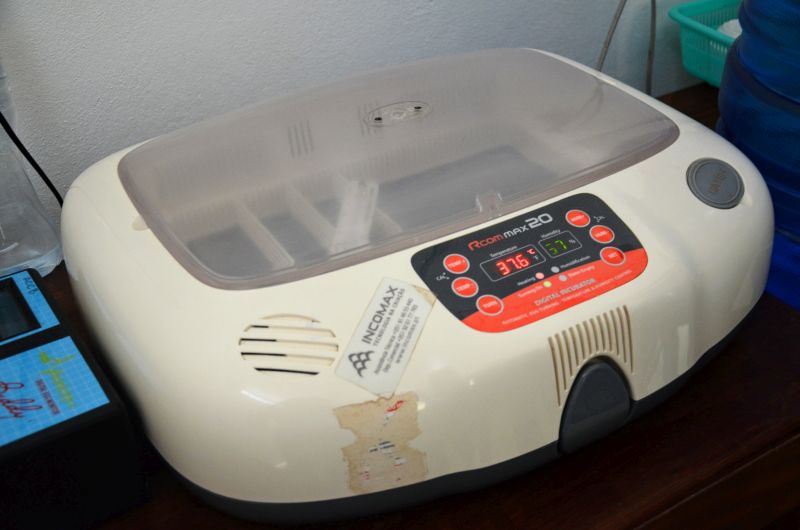Protecting the Critically Endangered Bengal Florican in Cambodia
Angkor Centre for Conservation of Biodiversity (ACCB); a project of the Allwetterzoo Münster, is a non-governmental organization and one of the first nature and endangered wildlife rescue and breeding centers, located in Phnom Kulen National Park, Siem Reap, Cambodia. ACCB has received support from a number of organisations, including the Critical Ecosystem Partnership Fund (CEPF) and the International Union for Conservation of Nature (IUCN).
The project jointly supported by CEPF and IUCN focuses on the ex-situ (off-site) conservation of Bengal Florican (Houbaropsis bengalensis) in Cambodia, one of the rarest bird species in the world. This species has a global population of fewer than 800 and is listed on the IUCN Red List of Threatened Species as Critically Endangered.
 Photo: Bengal Florican at ACCB Cambodia © IUCN/Noor Ali
Photo: Bengal Florican at ACCB Cambodia © IUCN/Noor Ali
"This joint Bengal Florican conservation program is extremely important for the long-term survival of the species. Close collaboration of the key project partners, including the involvement of community members make this project a success, safeguarding the Bengal Florican from extinction" - Hong Chamnan, Director of the Department of Freshwater Wetlands Conservation, Ministry of Environment Cambodia.
The first-ever Bengal Florican breeding facility in the world is set up at ACCB
As part of the ex-situ conservation program, ACCB established a captive population for the Bengal Florican. This assurance population is an essential component for their successful conservation in Cambodia and as a species. The project is conducted in partnership with the Ministry of Environment and the Wildlife Conservation Society (WCS) and complements their in-situ conservation work at the Bengal Florican Conservation Area at the Tonle Sap floodplain landscape.
 Photo: ACCB Cambodia © IUCN/Noor Ali
Photo: ACCB Cambodia © IUCN/Noor Ali
"By uniting expert knowledge and perspectives from all stakeholders we can bridge the gap between wild and captive population management and improve conservation efforts for the species as part of the One Plan approach to species conservation" - Christel Griffioen, ACCB Country Director
Threats facing the Bengal Florican in Cambodia
Cambodia is the most important country for Bengal Florican conservation, however, the species is exposed to several threats, such as extensive loss of natural habitats and human disturbance. Additionally, the spread of dry season rice cultivation in Cambodia is rapidly converting existing grassland habitat where the species resides.
“Cambodia is one of the last places where the charismatic and unique Bengal Florican occurs. The important work done by CSOs and key partners to conserve these species is extremely important for the long-term survival of the species. This project shows that partnerships can work to safeguard globally threatened species” - Alex McWilliam, IUCN Senior Programme Officer, Species and CEPF RIT Manager.
CEPF and IUCN Asia RIT visit ACCB
To monitor the ongoing progress of the project, capture lessons learned and see the Bengal Florican quarantine facility, designed to meet the species enclosure requirements, CEPF and IUCN Asia CEPF Regional Implementation Team visited the ACCB site in June 2022.
 Photo: IUCN RIT and CEPF at ACCB Cambodia © IUCN Asia
Photo: IUCN RIT and CEPF at ACCB Cambodia © IUCN Asia
ACCB egg collection and incubation process
It is the highest ex-situ management priority of ACCB and project partners to collect the Bengal Florican eggs from the wild while ensuring the lowest impact on the wild populations. During selected times within the breeding season, eggs, when spotted in the Bengal Florican grasslands areas within the Northern Tonle Sap Conservation Landscape, are carefully collected by ACCB caregivers in collaboration with the local community to prevent them from being exposed to additional threats.
 Photo: © ACCB/Pau Puigcerver
Photo: © ACCB/Pau Puigcerver
They are then transported to the ACCB where the eggs are artificially incubated and the chicks are hand-reared by experienced caretakers, establishing an assurance colony for the species, with the ultimate goal to of reintroduction of wild populations. The local community and ACCB follow the ‘Protocol for Bengal Florican Nest Reporting, Egg Collection and Transportation Schemes’ developed by the Ministry of Environment, ACCB and WCS.
 Photo: Bengal Florican egg incubator at ACCB © IUCN/Noor Ali
Photo: Bengal Florican egg incubator at ACCB © IUCN/Noor Ali
ACCB animal care takers aim to ensure the health and wellbeing of all Bengal Florican, including eggs that are being incubated and the chicks that successfully hatched, and effectively monitor the behaviour and health of the animals at the site. Currently, two full-time local animal keepers, ACCB’ Curator for Ex-situ Conservation and Veterinarian are providing professional care required for the species. They are directly working with the Bengal florican, hand-raise the chicks, monitor feeding patterns, behavior, health and general welfare.
 Photo: ACCB Bengal Florican caretaker © IUCN/Noor Ali
Photo: ACCB Bengal Florican caretaker © IUCN/Noor Ali
Since establishing the ex-situ management program in 2019, eight chicks have successfully hatched from wild-laid eggs that were found in the native grasslands. In 2020, two eggs successfully hatched, however in 2021 no eggs were collected. The reason for this being that in 2021, the project partners identified that eggs would only be collected in the month of July if the eggs or hatchlings, would be at risk of drowning due to seasonal flooding of the floodplain. Due to the rains staying out, the floodplain did not flood.
 Photo: Bengal Florican feeding © IUCN/Noor Ali
Photo: Bengal Florican feeding © IUCN/Noor Ali
At the end of April 2022, ACCB received a call to assist with the rescue of a Bengal Florican egg that was saved from actively burning grassland where the nest was located. When receiving information from ACCB in-situ project partners WCS/MoE that an egg has been found by the local community, their experienced team prepares a portable incubator to safely transfer the egg from the species’ natural habitat to the ACCB. The team members drive to the site, where they are met by a local community member and a representative of WCS/MoE.
 Photo: ACCB egg collection © ACCB/Pau Puigcerver
Photo: ACCB egg collection © ACCB/Pau Puigcerver
To not disturb the wild Bengal Florican population, the team walk to the nest location and carefully transfer the egg from the ground to a container filled with substrate, usually small seeds. This substrate is important to absorb vibrations and avoid unnecessary movement of the egg. Once the team return to their vehicle, the egg is transferred to the portable incubator which will ensure the egg maintains the correct temperature for incubation during the transport back to ACCB.
Upon arrival at ACCB, the team will candle (check if the egg is viable), measure and weight the egg before we transfer it from the portable incubator to the main incubator for artificial incubation.
The fertile egg collected in April 2022 was approximately one week old when it was found, and a healthy chick hatched after 19-days of artificial incubation.
 Photo: Bengal Florican egg © ACCB/Pau Puigcerver
Photo: Bengal Florican egg © ACCB/Pau Puigcerver
Going Forward
In order to be successful, this programme has to be managed for the next decades and additional enclosures will be needed in the future to provide adequate facilities for the assurance of the population of Bengal Florican Surplus captive born offspring. If the project is not implemented on a larger scale, the risk that the species will be extinct in Southeast Asia is higher than its survival.
ACCB plans to collect more data on Bengal florican to improve its practices and provide a suitable environment to conserve the species. For example, a proposed method is to utilize genetic testing of the floricans to assess how genetically diverse the breeding populations are.
“Local communities in Cambodia have an important role to play in Bengal Florican conservation, only together we will be able to save the species from extinction" - Christel Griffioen, ACCB Country Director
About CEPF
CEPF empowers non-governmental organizations, Indigenous groups, universities and private enterprises to protect the world’s biodiversity hotspots and help communities thrive. It is a joint initiative of l’Agence Française de Développement, Conservation International, the European Union, the Global Environment Facility, the Government of Japan, and the World Bank. In the Indo-Burma Hotspot, it is also supported by the Margaret A. Cargill Philanthropies. IUCN serves as CEPF’s Regional Implementation Team in the Indo-Burma Hotspot.



